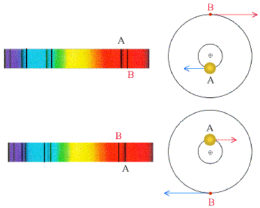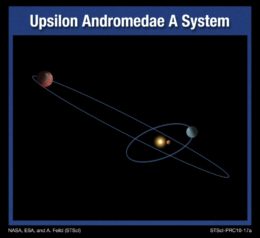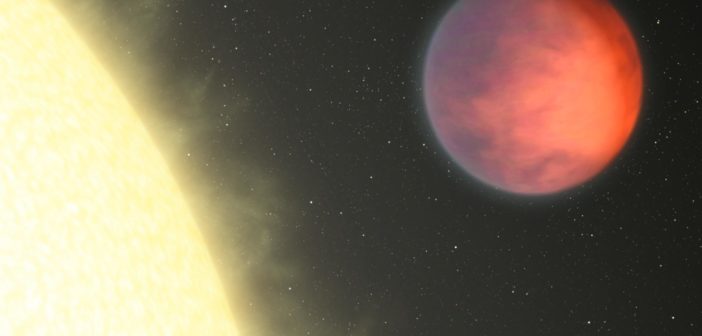What can we learn about exoplanets from high-resolution, ground-based observations? A new view of the nearby upsilon Andromedae system has revealed a great deal about the system’s closest-in exoplanet — including the presence of water vapor in its atmosphere.
Search for Wobbles

Illustration of how spectral lines shift when observing two objects that orbit each other. Click here to see a simulation of this process. [R. Pogge, OSU]
These planets, however, were not discovered due to transits; their orbital planes are not aligned with our line of sight to the star. Instead, the hidden planets were first detected via the star’s spectrum. The radial velocity method of detecting exoplanets searches for telltale periodic shifts of a star’s spectral lines, which are induced by the orbiting planets’ gravitational tugs.
In recent years, ground-based spectroscopy has become ever more powerful; thus revisiting old systems with higher resolution instruments can often open a whole new world of data to us. In the case of a recent study, a team of astronomers led by Danielle Piskorz (California Institute of Technology) revisited upsilon Andromedae with the high-resolution Near Infrared Spectrometer (NIRSPEC) at the Keck telescope in Hawaii. Their goal: to gather data about upsilon Andromedae b, the closest-in planet in the system.

Top-down schematic of the orbit of upsilon Andromedae b around its star and the location in the orbit of the authors’ observations. [Piskorz et al. 2017]
An Unusual Architecture
Piskorz and collaborators obtained 13 different sets of observations of upsilon Andromedae with NIRSPEC across three different wavelength bands. By treating the star–planet system as though it were a spectroscopic binary, the authors’ high-resolution observations allowed them to resolve not only the stellar spectrum, but also the spectral lines from the hot Jupiter exoplanet itself.
Obtaining a thermal spectrum of the planet permitted the team to break the usual observational degeneracy that occurs with exoplanet observations: they were able to disentangle the planet mass and its orbital inclination angle. Piskorz and collaborators found that the planet is roughly 1.7 Jupiter masses and its orbit is inclined ~24° relative to our line of sight.

Artist’s illustration of the closest three planets in the upsilon Andromedae system. The system also has a distant red-dwarf binary companion, as well as a possible fourth planet. [NASA/ESA/A. Feild (STScI)]
Water Found
One of the biggest benefits of spectroscopy of an exoplanet is the potential to learn about its atmospheric composition. Using their NIRSPEC observations of upsilon Andromedae b and detailed atmospheric modeling, Piskorz and collaborators found that the planet’s opacity structure is dominated by water vapor at the wavelengths they probed.
This detection of water vapor in upsilon Andromedae b’s atmosphere and the constraints on the planet’s orbital properties demonstrate the power and potential of ground-based, high-resolution spectroscopy for characterizing exoplanets and constraining the architecture of distant solar systems.
Citation
Danielle Piskorz et al 2017 AJ 154 78. doi:10.3847/1538-3881/aa7dd8
